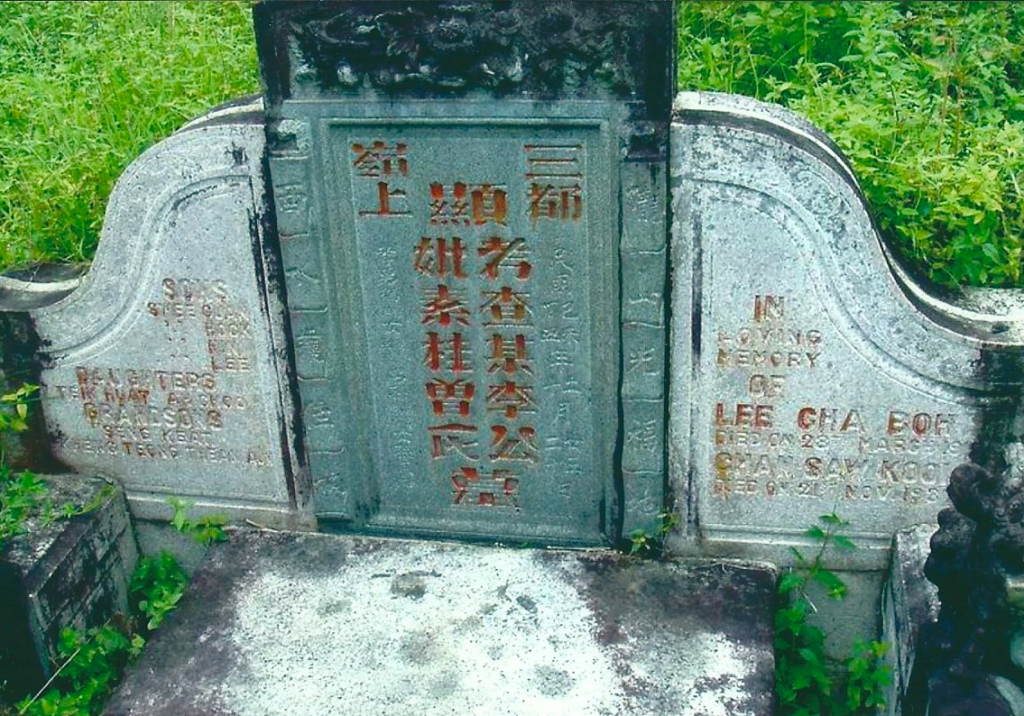This is the second biography within the works Family Stories.
Chan Saw Kooi was the local wife of Lee Yew Beng. Similar to her husband, information is scare on her life. Life before marriage was undocumented and a complete unknown; likely it has been lost permanently since no immediate descendants (children) are alive today to provide information. No photograph has been known to exist of Saw Kooi and thus no photographic evident of the couple together is available.
Chan Saw Kooi met Lee Yew Beng in Penang around the turn of the century. Culturally, that period in history combined with the geography of then Malaya and the British Straits Settlements, would have seen a mesh of the outgoing Chinese Qing dynasty. With the Boxer Rebellion and weak rulers in China, mass migration of Chinese was afoot. As part of that historical context Lee Yew Beng was no doubt one of many young Chinese seeking stability and fortune abroad.
Recent information shared by the youngest grand-daughter, who would have in turn received the information from her parents, indicates that the marriage between Yew Beng and Saw Kooi was entirely the young couples doing, independent of their parents. Yew Beng may have had assistance from the Lee Kongsi in Penang, but details like that remain pure speculation.
Chan Saw Kooi’s preeminence as wife was challenged by her mother-in-law who had previously arranged for her son, Yew Beng, to be betrothed to another girl who had already gone to stay with the family back in China. When Yew Beng’s mother learnt of the local marriage, she brought the betrothed girl with her to Penang. There at the jetty, she threatened to curse Yew Beng unless he honoured the family by fulfilling the arranged marriage. Saw Kooi could only watch from the sidelines as her husband reversed his initial refusal to take the girl.
The union of Yew Beng to this China-born girl led to the birth of one son – Swee Hock. Having fulfilled his obligation, Yew Beng then returned to Saw Kooi and together they had two more sons and a daughter. It is suspected that Saw Kooi’s lineage/background had Thai influences, given her reddish/black curly hair. Based on stories shared by the two daughters-in-law to the youngest grandchild, Chan Saw Kooi was a colourful character known for her stories, trickery and gambling. Given that Chan Saw Kooi relied on the men in her life to provide financially for her. When her two youngest sons would or could not have the money to finance her gambling habit, she would go to the grocery and order stocks of food and incurring charges billed to her sons. The two sons also had differing attitudes and response to their mother’s gambling habit – Swee Lee, as the youngest was not tolerant and therefore was not as kind as she would have liked, whilst Swee Hin aligned with his mother’s view on living for the day. This unfortunate reputation of being a gambler, and this vice ultimately led to the death of her husband, when her use of the tin mine’s funds caused him such distress that he took his life.

Given her gambling addiction, Chan Saw Kooi was unlikely to be an instrumental role model for her family, and various stories seemed to indicate that her relationship with step-son Swee Hock was the source of friction between him and her own blood-line sons. This tension was evident after the death of her husband and the remaining family fought over what details were to be inscribed on the tombstone. The fact remains that the eldest grandson from Lee Swee Hock, Hun Hoe (born 1925), was omitted from the list of grandsons, whilst the three grandsons listed correspond to each of the other three brothers’ first born sons. What role Saw Kooi played in deciding that the tombstone would be inscribed as “Lee Cha Boh” instead of “Lee Yew Beng” is unclear.
A period of about 15 years existed between the birth of the youngest son Swee Lee and the last child and only daughter – Teik Huat. This gap is considered quite long more so when given the practice in those days was to have children quite frequently. The age gap between children unfortunately meant that the children were not as close. The nature of Saw Kooi’s relationship with Swee Hock, as mentioned earlier, was unclear and was a source of tension in those days of the family. Whatever was thought, Chan Saw Kooi did spend a few years of her later life with Swee Hock in Kuching before returning to Penang as the final chapter in her life. In part, this also explains why there is so little information known about her life; the grandsons (including my father) did not grow up in Penang with their grandmother present in their lives.
Another point of confusion reflects on the tombstone details which Saw Kooi shares with her husband Yew Beng. The presence of the name “Ah Mooi” as another daughter is another piece of information hard to explain. The closest explanation available today comes from the senior grandchildren of the Swee Lee household – that Ah Mooi was in fact a servant girl, not that much older than the oldest son. So, either she was a servant girl mistakenly added to the tombstone of some other family secret entitled her to a name position on the tombstone, either instrumented by the surviving family or enshrined by the widowed Chan Saw Kooi.
Chan Saw Kooi died on Sunday, 21 November 1937 and her funeral wake was conducted with full rites, customs and traditions in line with the family Taoist beliefs of ancestor worship. Her burial in the same family tomb saw the details updated to include her details, but still the listing of grandsons remained unchanged.


2 comments
Comments are closed.